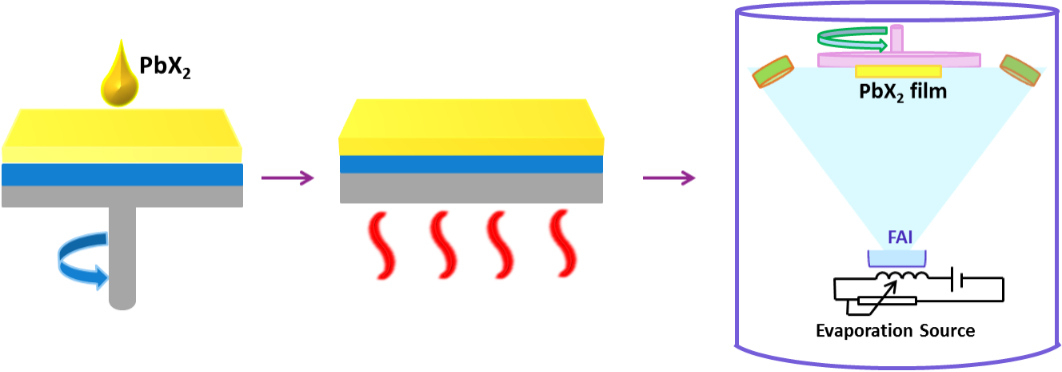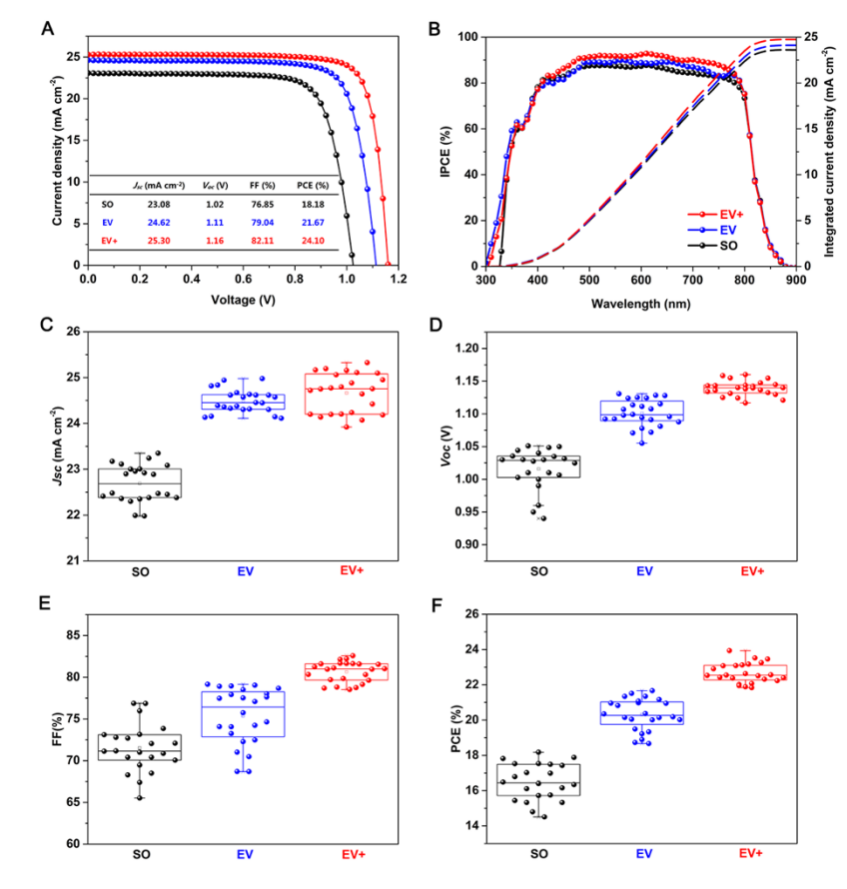Recently, a research team of Yi Chenyi, a professor of the Department of Electrical Engineering and Applied Electronics (EEA) of Tsinghua University, prepared high-quality perovskite film by combining vacuum thermal evaporation with traditional solution deposition, which breaks the highest record of methylamine-free CsxFA1-xPbX3 (CsFA) solar cell efficiency, and the research is published on the international academic journal “Joule” (impact factor 41.2).
Compared with MA-contained perovskite, MA-free CsxFA1-xPbX3 perovskite is an ideal optoelectronic and photovoltaic material because of it has suitable band gaps and better stability. However, the photoelectric conversion efficiency of cesium formamidine-based perovskite solar cells is significantly lower than that of MA-contained perovskite solar cells due to the difficulty in controlling the crystallization process and film morphology of CsxFA1-xPbX3 perovskite. In response to this problem, the research team prepared a smooth and uniform CsxFA1-xPbX3 perovskite film by combining vacuum thermal evaporation to prepare iodoformamidine (FAI) with traditional solution deposition to prepare lead halide precursor (Figure 1).

Schematic diagram for preparing CsxFA1-xPbX3 perovskite via evaporation

Solar cell efficiency based on CsxFA1-xPbX3 perovskite film prepared by different methods
(Black is by traditional solution deposition, blue is by solution+evaporation, and red is by solution+evaporation with PbCl2 added to the raw material)
Compared with the traditional solution deposition, the vacuum thermal evaporation can produce a thickness-controllable and consistently uniform iodoformamidine (FAI) film, which promotes the subsequent chemical conversion reaction between FAI and lead halide, and the perovskite film obtained has fewer structural defects and better electrical properties; on this basis, by adding an appropriate proportion of lead chloride to the lead halide precursor, the crystal size and crystallinity can also be increased, thereby further improve the quality of CsxFA1-xPbX3 perovskite film.
The solar cells prepared by this method exhibited excellent optoelectronic properties and achieved the highest photoelectric conversion efficiency of 24.1% (certified value of 23.9%) under standard AM 1.5G illumination (Figure. 2), which is the highest record for CsxFA1-xPbX3 perovskite solar cell efficiency reported up to now. Compared with the CsxFA1-xPbX3 perovskite solar cells prepared by the traditional solution method, the device prepared by this method exhibited more excellent long-term photostability, thermal stability and humidity stability. The unencapsulated evaporated solar cell still maintains 95% of the initial photoelectric conversion efficiency after being placed in dry air for 20,000 hours. In addition, this method is suitable for the preparation of large-area cells, and through this method, the research team achieved a photoelectric conversion efficiency of 22.8% within an aperture area of 1cm2.
This process of preparing CsxFA1-xPbX3 perovskite by introducing vacuum thermal evaporation has a high tolerance to the production environment, and it can still prepare devices with excellent performance in the summer with ~50% relative humidity, and the repeatability is favourable. Suitable for industrial production. This work demonstrates the superiority of vacuum thermal evaporation in preparing highly uniform perovskite films and the feasibility of industrial application.
The above achievement was published in the international academic journal Joule under the title of “Over 24% efficient MA-free CsxFA1-xPbX3 perovskite solar cells”. The co-first authors of the paper are Wang Siyang, a research assistant, Tan Liguo, a doctoral student admitted in 2019, and Zhou Junjie, a doctoral student admitted in 2018, and the corresponding author is Associate Professor Yi Chenyi of the Department of Electrical Engineering. The collaborators include Ding Liming, a researcher at the National Center for Nanoscience and Technology, and Ph.D. Wolfgang Tress, Zurich University of Applied Sciences, Switzerland, and Professor Michael Graetzel of the Swiss Federal Institute of Technology in Lausanne, etc. The work was supported by the National Natural Science Foundation of China, the independent scientific research project of the State Key Laboratory of Electric Power Systems, and the National Grid National Energy Biological Research Project Fund.
Relying on the platform of the State Key Laboratory of Power Systems, the research team has long been committed to the whole-chain research and development of key material, preparation process and energy storage integration of perovskite solar cells.
On the occasion of the 90th anniversary of the establishment of the Department of Electrical Engineering of Tsinghua University, the breakthrough of this research is undoubtedly the best gift from the research team to the celebration.
Paper link: https://www.sciencedirect.com/science/article/pii/S2542435122001933

















 News & Events
News & Events